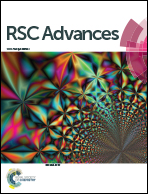Nitrogen-doped porous carbon with a hierarchical structure prepared for a high performance symmetric supercapacitor†
Abstract
Here, we present a facile approach to synthesizing nitrogen-doped porous carbon materials (NPCs) through carbonization of poly(o-phenylenediamine) (PoPD) by using molten-salt as a template. The as-prepared NPCs exhibit hierarchically micro-nanometric porous structure and unprecedented nitrogen content (14.86 wt%). The micrometric pores are interconnected which form from the micrometric salt droplets during carbonization, while the nanopores are generated by the exclusion of small molecular gases. This unique structure and high nitrogen content endows the NPCs with excellent specific capacitance (364.93 F g−1 at 2 mV s−1) and good cycling stability (92.3% capacitance retention at 10 A g−1 after 5000 cycles) in 6 M KOH electrolyte. Moreover, the symmetric supercapacitor array fabricated with the NPCs can easily power a light-emitting diode (LED), demonstrating the practical application of the NPCs in energy storage.



 Please wait while we load your content...
Please wait while we load your content...